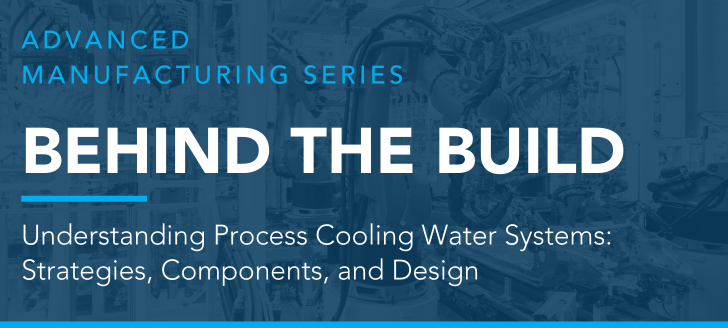
Process Cooling Water Systems
Process cooling water systems play a critical role in advanced manufacturing facilities. They regulate temperature, protect equipment, and help ensure consistent product quality, yield, and throughput. However, to do so reliably, the systems need to be designed around operational demands, considering everything from capacity and performance expectations to cost and maintenance goals. That’s why a thoughtful approach to system design matters. It needs to take into account the overall strategy, the components that support it, and the factors that affect long-term reliability and efficiency. Understanding the typical system approaches, core components, and key design factors can help ensure the system is aligned with the facility’s needs from day one.
Process Cooling System Strategies:
Process cooling systems are typically designed as either open-loop or closed-loop systems, depending on the specific needs of the operation. Each approach comes with its own functional differences and cost considerations,
- Open-Loop Systems: Water is cooled in an open basin with direct contact to air, most commonly in the form of a cooling tower. Heat is removed through evaporation, and the water is then pumped back to the process or a heat exchanger. These systems often have a lower up-front capital cost, but have higher continuous operational costs. Additional chemical injection systems are required for water treatment to control corrosion, scale, and biological growth. These systems also have a higher makeup water demand to account for evaporative losses.
- Closed-Loop Systems: Water/glycol is circulated through a sealed loop across process loads and a heat rejection device, most commonly in the form of a chiller. In a closed-loop system, the cooling fluid never enters into direct contact with ambient air. These systems often have a higher up-front capital cost but have lower continuous operational costs and require less maintenance and upkeep.
Common Components in Process Cooling Systems
Regardless of the system strategy, most process cooling setups rely on a core group of components working together to manage flow, temperature, and pressure. Each plays a distinct role in maintaining stable and efficient operation.
- Cooling Towers: Remove heat from water through evaporation in an open-loop system. They are essential for rejecting process heat to the atmosphere in a cost-effective way, especially in large-scale applications.
- Chillers: Utilize mechanical refrigeration to cool water to precise temperatures, can be air-cooled or water-cooled. Chillers are critical when process loads require tighter temperature control or when ambient conditions aren’t suitable for evaporative cooling.
- Heat Exchangers: Transfer heat between open and closed loops, often utilizing plate-and-frame or shell-and-tube type. Heat exchangers can eliminate direct contact between the cooling medium and process equipment.
- Pumps: Are required for fluid circulation through the system. They can be constant-speed or variable-speed, depending on flow requirements and energy efficiency goals
- Expansion Tanks: Absorb volume changes as water temperature changes, maintaining a constant system pressure.
- Buffer Tanks: Provide additional fluid volume to the system, maintaining consistent flow during load fluctuations.
- Chemical Treatment: Required in an open-loop system to inject corrosion inhibitors, scale reducers, and biocides to maintain water quality.
- Control Valves & Sensors: Manage flow rates, differential pressures, and temperatures for stable operation and system management.
Key Considerations for System Design
Even experienced teams can run into issues when critical details are overlooked during the design process. Factors like redundancy, flow provisions, structural capacity, and energy efficiency all play a role in long-term reliability, safety, and cost.
- Redundancy: A single failed component can cause the entire plant to halt production. Considering various redundancy options is critical for system design.
- Inadequate Flow Provisions: Careful consideration must be given to freeze protection, bypass piping, and minimum flow requirements. If not properly accounted for, they can lead to unstable operation, reduced equipment life, or unexpected performance issues, especially under low-load or cold-weather conditions.
- Structural Analysis: For large chilled water systems, a comprehensive structural analysis is essential to confirm the load capacity of existing steel frameworks and evaluate the feasibility of incorporating ground-mounted pipe racks.
- Energy Efficiency: Free cooling, heat recovery, and thermal storage can all significantly affect a system’s energy consumption and operating costs.
What does all this mean for advanced manufacturing facilities?
It means that process cooling water systems should be treated as a core part of operational planning. The right strategy, supported by disciplined design, robust components, and tight coordination, can deliver decades of reliable and efficient performance, helping to protect equipment, control costs, and support consistent production.
At ARCO/Murray, we understand these challenges and can deliver a system that keeps pace with all of your production needs. Have questions or want to discuss which process cooling water system might be best for your operation? Let’s talk!

Patrick Flanagan
Project Manager

Nick O’Hare
Director of
Business Development